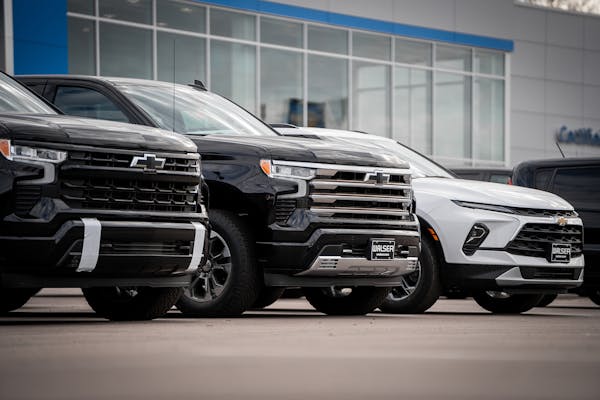Cars on the Fury Motors lot in South St. Paul were strategically spaced out last year to conceal the shortage of vehicles.
As supply-chain issues ease, dealerships like Fury no longer have that problem. "We about doubled our inventory from last year," Justin Olmeim, general sales manager at Fury's South St. Paul location, said.
But car buyers now face a new challenge: Vehicles have never been less affordable.
Average monthly payments reached a record high of $733 in the second quarter, up more than $50 from a year ago, according to the Edmunds.com car shopping guide.
What's more, the share of consumers who financed a vehicle with a monthly payment of $1,000 or more reached an all-time high of around 17% vs. under 5% in 2019. Many of these buyers are spreading payments over seven years.
"For favorable monthly payments, you want low interest rates and big discounts or generally cheap cars," said Joseph Yoon, an Edmunds consumer insights analyst based in Los Angeles. "But we don't have any of those elements. We don't have low interest rates. We don't have discounts. I know many people paying over sticker for cars."
Worldwide pandemic shutdowns led to shortages that drove up prices of new and used models after consumers couldn't find what they were looking for.
And while dealers this year have a greater supply of both new and used cars, the purchasing economics are difficult in new ways. Manufacturers are offering fewer entry-level vehicles and the average annual percentage rate climbed above 7%, the highest since 2007, Edmunds reported.
"There's no good way to buy a car right now, except do you have money, and most people don't," Yoon said.
He recommends that the majority of buyers who finance vehicles should consider larger down payments to avoid exorbitant payments, as the average amount financed remains above $40,000.
Karl Brauer, an executive analyst with iSeeCars.com, says there are market signals that give reason for optimism.
"Now, there are deals out there to be had," Brauer said. "Prices are well above pre-pandemic, but not on all of them. Some models are down."
An iSeeCars.com study shows used-car prices dropped an average of $1,237 in June compared to a year earlier. In the Twin Cities, the decline averaged $845.
The Tesla Model 3, Ford Mustang, Land Rover Range Rover Velar and Mini Cooper Countryman were the used models with the biggest price drops here, the study said.
Tom Leonard, owner of Fury Motors and the Minnesota Automobile Dealers Association chair, believes the environment to buy a car is better than it has been in the past year and a half for consumer affordability.
"Eighteen months ago, it hit a real low point for a year and now it's come back in the last six months to where we have more supply and easing on upward prices," he said.
Scott Corson, an avid and frequent buyer of new vehicles, turns to dealers where he has a relationship to secure better deals. Corson suggests negotiating or turning to credit unions for lower-cost borrowing.
Those who overpaid during the pandemic might want to wait in case of negative equity.
"You've got people who paid $10,000, $20,000 over [manufacturer's suggested retail price]," said Corson of Inver Grove Heights, who averages two new car purchases a year. "Boy, you're stuck with that for a while."
Brauer recommends buyers wait until they absolutely need to buy a vehicle and keep it for 10 to 15 years. "You buy a three-year-old car letting someone else take the depreciation," he said. "Then, you drive it until the wheels fall off."


